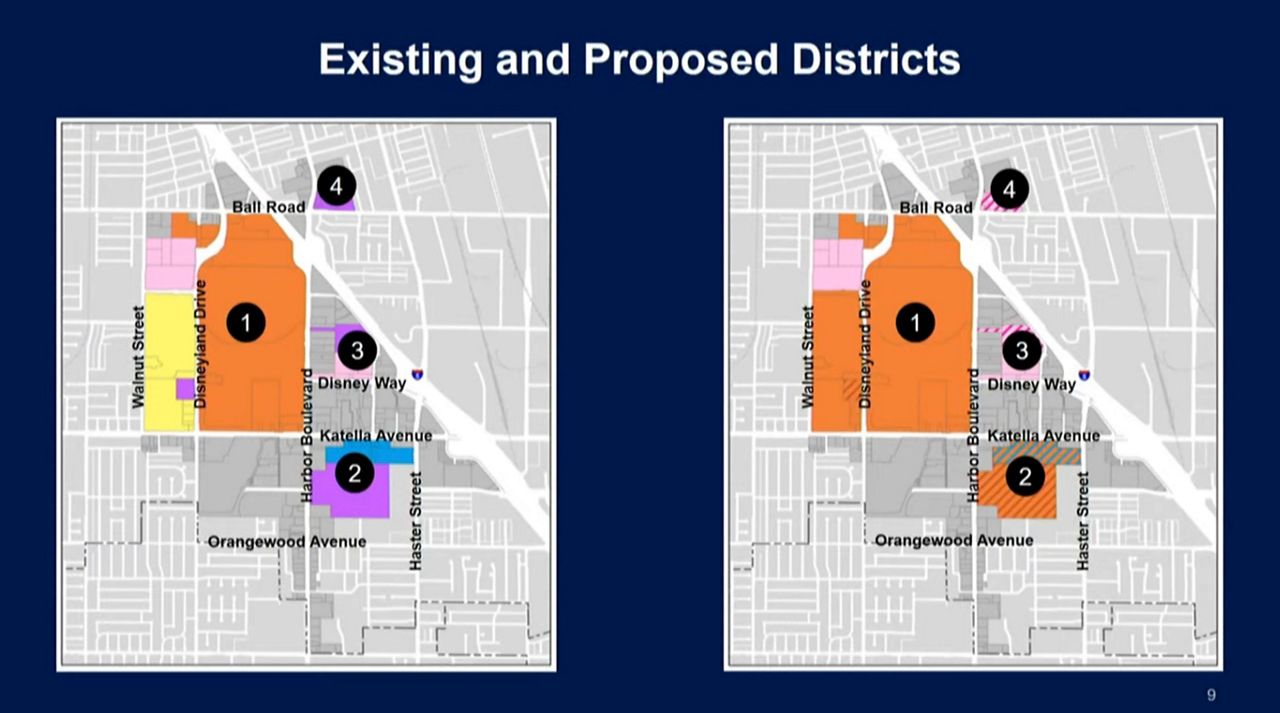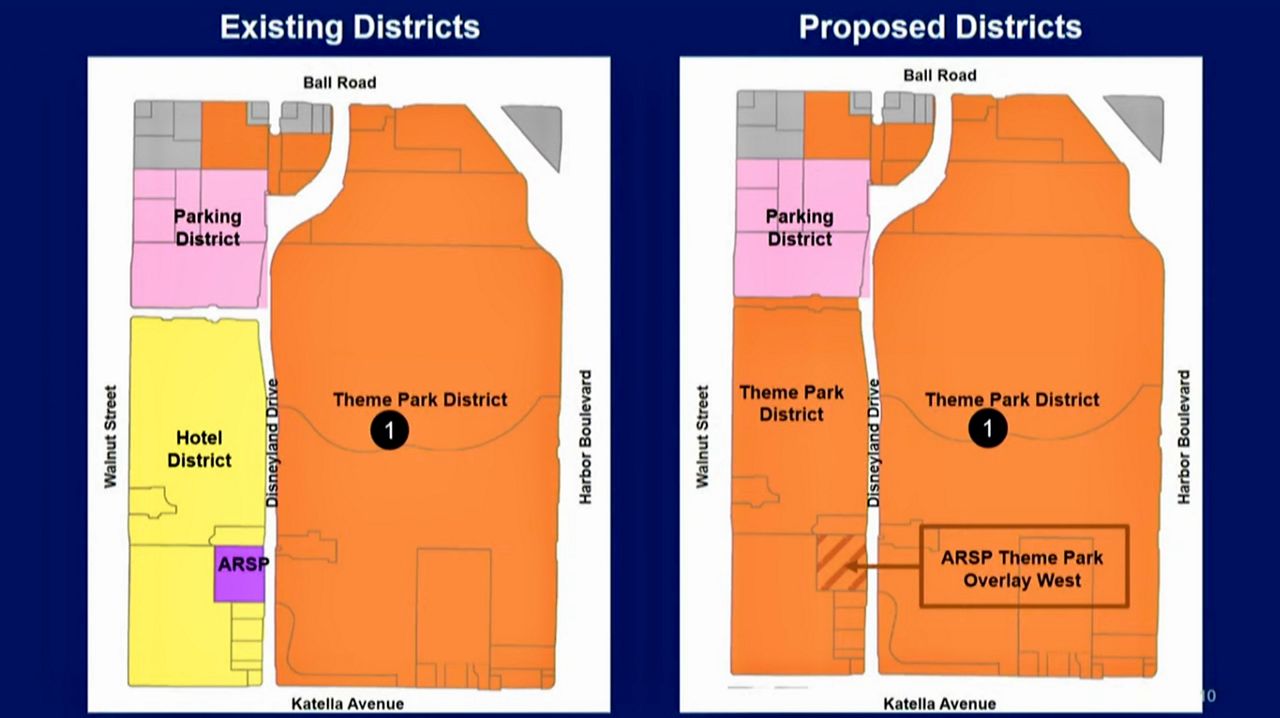EDITOR'S NOTE: Multimedia journalist Logan Hall spoke with an Anaheim resident about the new Disneyland proposal. Click the arrow above to watch the video.
ANAHEIM, Calif. — The Walt Disney Co. said it would invest at least $1.9 billion in the first ten years of the 40-year Disneyland Resort's DisneylandForward project — if it receives the Anaheim City Council's blessing.
During a crowded public hearing in city hall Tuesday, Anaheim city staff laid out Disney's DisneylandForward's plan and development agreement.
Staff told the City Council that the billions Disney planned to invest would go towards "visitor-inducing uses" such as developing more theme park attractions, hotels, retail, dining and entertainment.
Disney even tacked on a little rider, stating that if the company did not invest at least $2.5 billion in the project within the first ten years, the city would receive an additional $5 million payment.
After two years of selling DisneylandForward to the community and local business leaders, Disney is ramping up the pressure on the city to approve the project that rezones much of the company's 490-acre theme park footprint in Anaheim's so-called Resort District.

Disney is asking the city to rezone their existing property as mixed-use, meaning the allowance of building attractions, hotels, shopping, dining, and entertainment together rather than in specifically independently designed zoning areas.
The company has made it a point to say that they are not asking for additional square footage and hotel rooms beyond what was already approved by the city in the 1990s. They are also not asking for any public money.
In the original agreement, the city allowed Disney to build 6.8 million square feet of theme park space. But as of today, the company has built less than half that.
According to the plans, Disney aims to rezone several current parking areas, such as the Toy Story lot near the Anaheim Convention Center and Simba lot in Downtown Disney.
The rezoned space could pave the way for a new monorail connector, a 17,000-stall parking structure, pedestrian bridges, a PeopleMover, a Skyway, or even a new third theme park.
"Just imagine what we could do with this space," said Rachel Alde, the vice president of Global Development at Disney, during an Anaheim community webinar held Tuesday. "Right now, it's surfaced parking lots. But what if it could become the first-ever land based on Wakanda?"
Alde teased the possibilities of Disney Imagineers building themed lands and attractions based on "Zootopia," "Coco" or the fictional land of Arendelle from "Frozen."
On Tuesday afternoon, the public and the City Council got to hear Disney's proposed plan, the development agreement between the city and the company and community benefits.
Disney officials said aside from the $2 billion in the theme park and resort investments, they would commit $30 million to fund a city-created and controlled public housing trust. Disney would deposit half of that within the first year following the project's approval and the remaining balance within five years.
City staff said the city would have full discretion regarding how the money is used to support its affordable housing programs.
Disney added it would also give the city $8 million in the first year to improve and enhance the city's public parks and $10 million to improve the sewer lines on Katella Avenue.
Additionally, in exchange for taking over some public streets as part of the project, Disney will pay the fair market value of the properties appraised at $40 million. Disney has proposed the city abandon a stretch of Magic Way between Disneyland Drive and Walnut, a small access on Disney Way, and a stretch of Clementine Street off Katella Avenue.
Staff said the revenue would go to the city's general fund for future traffic and transportation improvements.
Disney added that through the life of the 40-year development agreement, they would continue their commitment to workforce development and jobs programs, including high school mentorships, career development, grants, and more.
Disney also would support fire and police by reimbursing the city for police officers assigned to the resort area.
"We listened to Anaheim's leaders and worked hard to address what is important for the city," said Disneyland President Ken Potrock in a statement. "We are proud that DisneylandForward will provide many important benefits directly to the residents of Anaheim."

Alde told the City Council that DisneylandForward is a way to meet a changing consumer marketplace and modernize Disneyland and the city's old 1996 master plan agreement.
"That means evolving to meet customer demand and allowing for more flexibility with the resort as a whole," she said. "We want to create more integrated experiences so that's not developments that separate theme park, retail, dining and hotels in different locations but really look for ways they integrate together."
"This allows us to create more immersive experiences," she said, showing slideshow examples of Disney's latest integrated and immersive themed lands in Hong Kong, Shanghai, and Japan.
Several City Council members questioned the viability of Disney's affordable housing contributions. The average cost to build an affordable housing unit is about $550,00 to $600,000, city staff said.
One public commenter said Disney's $15 million contribution would only create 25 affordable housing units.
Councilwoman Natalie Rubalcava said she would like to see Disney commit to "in perpetuity additional funding for housing whether it's a first-time home buyer program or last mile funding for affordable housing projects or even housing vouchers."
"I would love to see that in addition to the $30 million," she said. "That would keep our housing trust funded."
More than 50 community members spoke at the meeting, nearly split down the middle regarding the project.
"They cannot build a Walt Disney World in the middle of Anaheim," said long-time Anaheim resident Jeanine Robbins, adding that Disney should pay their workers a living wage.
Sixty-year Anaheim resident Anne Steib supported Disney's plan.
"Most residents would agree with me that Disney should be allowed to spend their own money to build on their own property to improve the Disneyland Resort," she said. "I see nothing but a positive outcome with this project."
With the conclusion of the public workshop, the DisneylandForward project will now move to the Anaheim Planning Commission for possibly another public workshop in February or a formal hearing in March to vote on zoning items.
The City Council could vote on the DisneylandForward zoning and development agreement as soon as April, city officials told Spectrum News.



